A Brief History of the Silver Three Cent Piece
The silver three cent piece is a remarkable coin in many ways. First, it is the lightest coin ever issued by the United States Government. Second, it is the first U.S. coin that had an intrinsic value (metal content) which was officially less than its face value. Finally the coin is an unusual example of where the U.S. Treasury coordinated the issuance of a coin with another government agency, the Post Office.
A version of the U.S. Postal Service was in existence before the 13 original colonies won their independence from England. Unfortunately the cost of mailing a single folded sheet of paper was more than many citizens could afford. In 1816 it cost six cents to mail one sheet of paper, without an envelope, 30 miles or less. Beyond 30 miles the rates got progressively higher until the cost reached 25 cents to mail one sheet of paper 400 miles or more. To put these prices into perspective, a dinner at a fancy New York City restaurant, Delmonico’s, cost 12 cents. Since the party receiving the mail was required to pay the postage in order to get the letter, the receipt of mail often posed a financial burden for a poor family.
In the mid 1840s the Post Office department introduced the concept of pre-paid postage where the sender paid the mailing fees. The mileage bands were reduced from five to two, and the postage rates were lowered to five and ten cents for each mileage band. The Post Office also began to issue the first U.S. stamps, a five cent stamp with Benjamin Franklin on it and a ten cent piece that featured George Washington. Finally in 1851 the postage rate was lowered to three cents, and shortly thereafter pre-paid postage became the official policy. The three cent postage rate would stand more than a century.
The introduction of the three cent postage rate posed a problem for stamp purchasers. Large cents had never been popular and had never circulated well outside of the largest cities. Government officials noted that many people would not often have three large cents to buy a stamp, and that post offices could run short of large cents that would be required to make change. The three cent piece was a logical solution.
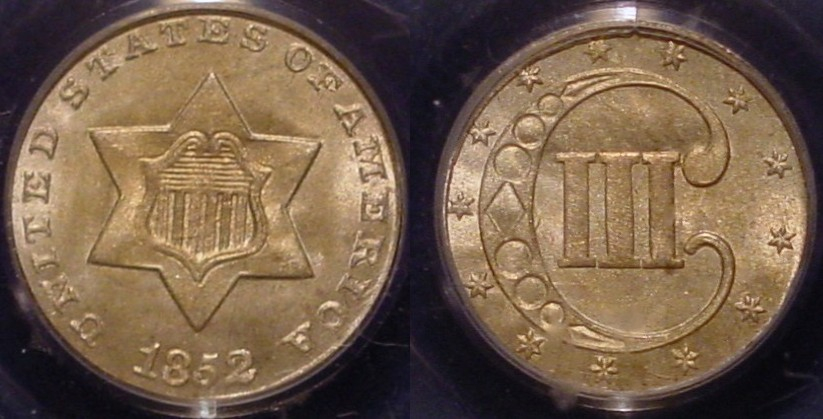
Given its small size, the Silver Three Cent Piece or “trime” had a very simple design. The obverse featured a five pointed star surrounded by the legend, “United States of America,” and the date. The reverse featured a large “C” that encompassed the Roman numeral “III.” These devices were encircled by 13 stars.
The discovery of gold in California had altered the price ratio between gold and silver to the point where all U.S. silver coins had a melt value that exceeded their face value. To keep the trime in circulation, the alloy was set at 75% silver and 25% copper instead of the usual 90% - 10% ratio. Therefore it was no secret that melting trimes was unprofitable because the coin contained less than three cents worth of silver.
The new three cent pieces were an immediate hit as evidenced by the number well worn examples that collectors see today of the early dates from 1851 to 1853. Yet the coin had one major drawback. The trime was so small and thin that it was virtually impossible to lift the coin from a flat surface. Hence the public gave the coins the derisive nickname, “fish scales.”
In 1853 Congress lowered the weight of the half dime, dime, quarter and half dollar to put an end to the widespread melting of those coins. Arrows were placed beside the date of the coins to indicate that the weight of these pieces was lower. In 1854, Congress increased the purity of the trime to 90% silver and 10% copper to bring the coin in line with the rest of the U.S. silver coinage. This change in composition was marked by a modified design. The so-called Type 2 trime had two lines around the star on the obverse, and an olive branch and a bundle of arrows was added above and below the “III” on the reverse.
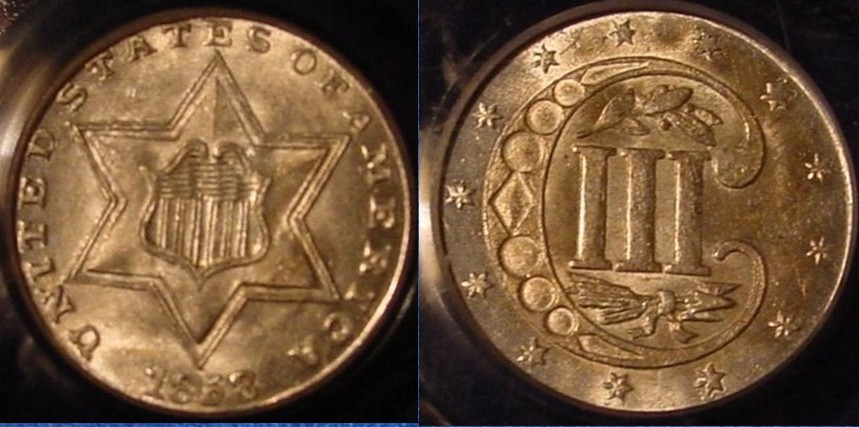
The Type 2 trimes (1854 to ’58) are much scarcer than the Type 1 pieces, especially in Mint State. The annual mintages were lower because many of the earlier pieces were still in circulation. There were also technical issues with the sharpness of the strike. For whatever reason, the Philadelphia mint could not strike the more complicated design well. As a result many Type 2 trimes wore out before their time.
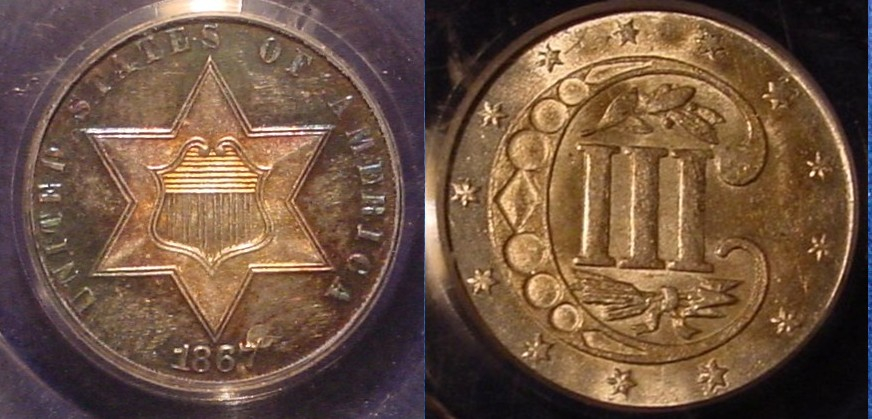
In 1859 the technical problems with Type 2 trimes prompted designer James Longacre to modify his design. The Type 3 trime had one outline around the large obverse star instead of two. The resulting coins were much sharper and more attractive.
The outbreak of the Civil War prompted widespread hoarding of U.S. coinage. Many pieces were shipped to Canada and the Caribbean where money changers paid a premium for them. Far less silver was brought to the Philadelphia mint for coinage, and the mintages for all silver coins were low.
The trimes were especially hard hit by this change. Mintages of business strike trimes fell to very low levels, and what few coins that were struck never made it to circulation and were subsequently melted. Today the surviving trimes dated from 1863 to 1873 are almost exclusively limited to Proof coins. In 1873 Congress ended the coinage of trimes. By then the Nickel Three Cent Piece had become a more popular and practical alternative.
Comments
Nice article! Thank you @BillJones !
BST transactions: dbldie55, jayPem, 78saen, UltraHighRelief, nibanny, liefgold, FallGuy, lkeigwin, mbogoman, Sandman70gt, keets, joeykoins, ianrussell (@GC), EagleEye, ThePennyLady, GRANDAM, Ilikecolor, Gluggo, okiedude, Voyageur, LJenkins11, fastfreddie, ms70, pursuitofliberty, ZoidMeister,Coin Finder, GotTheBug, edwardjulio, Coinnmore, Nickpatton, Namvet69,...
Yes, Nice Article. Here are some examples I have images of from my collection. Thanks @BillJones
Excellent!
My YouTube Channel
Great reading. Thanks for posting.
Thank you
Wayne
Kennedys are my quest...
Given the timing of the change in postage payment practices, I am not 100% certain that this story is true, but I have read it from a couple of sources.
When Zachary Taylor was elected president in 1848, he was at his plantation in Louisiana. News traveled slowly in the mid 19th century. A letter was sent him notifying him that he had won the election. The story was that he refused to pay the postage on the first letter and therefore did not learn about his new office for a few days longer.
Here is an 1848 Zachary Taylor presidential campaign medalet. The DeWitt variety number is ZT 1848-17.
Nice write up thanks for posting.
"That's why I wander and follow La Vie Dansante"
Thanks, educational threads are always welcome.
Cool, thanks for the info 🌞
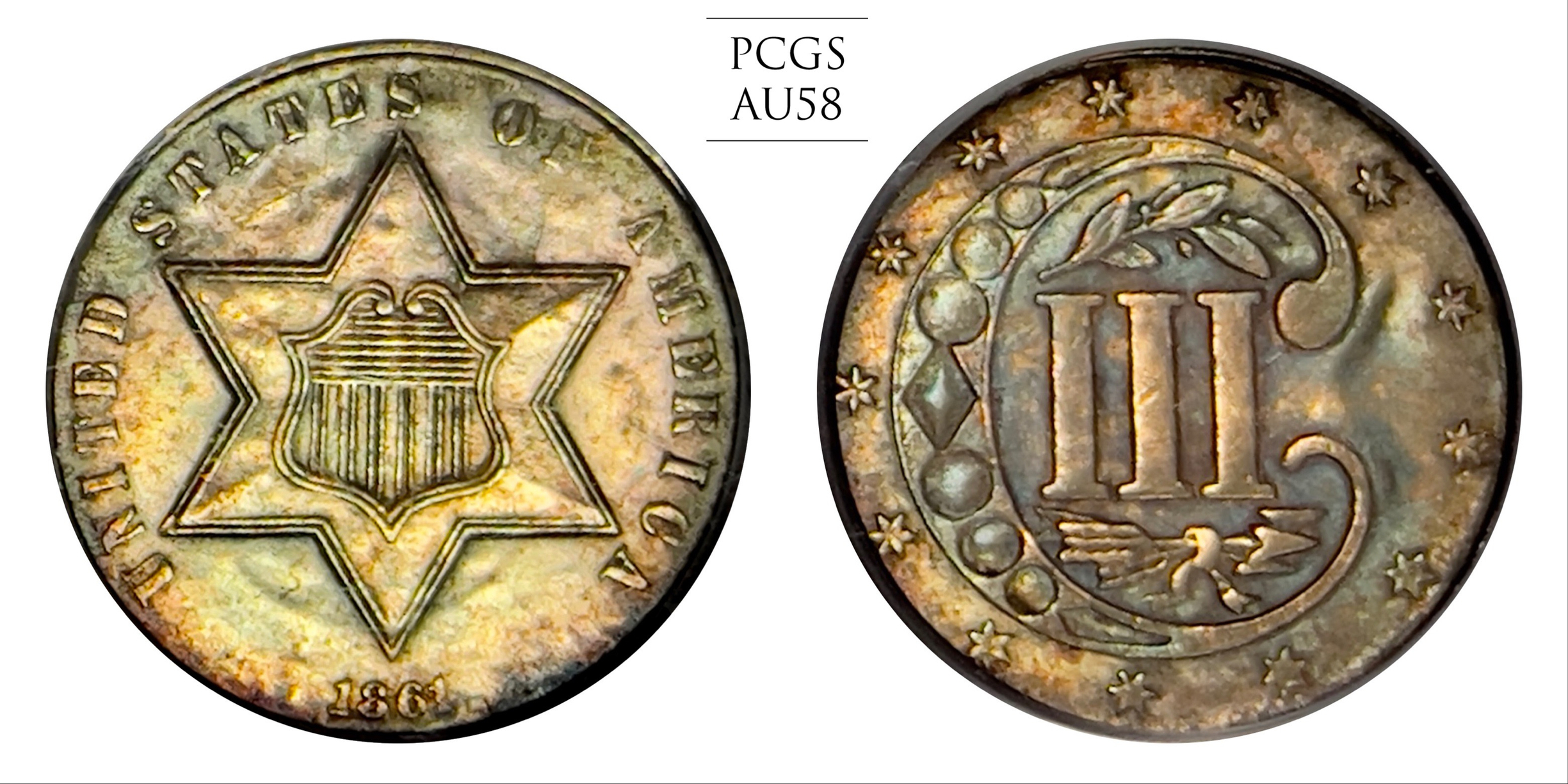
Mr_Spud
Great post and images, Bill.
I've always thought it a bit curious that the denomination just sort of died out even though the postage rates stayed the same until ca. 1958. I wonder that there was just a saturation of low denomination change brought about by the mintage of the bronze cent, the 2 cent coin and the new nickel in 1866?
The Silver Three Cent Piece was too small to be convenient. The nickel coin was better, but it seemed to die out. Perhaps people bought stamps in quantity so that the three cent coin was not really that necessary. Instead of standing in line to buy one stamp they bought more at a time and dropped letters in mailboxes instead.
Excellent! The coinfacts estimates for surviving examples for the dates 1863-1872 circulation strike coins are inaccurate and way too high, IMHO. The price guides for circulation strike dates from 1863-1872 circulated examples are low-even the PCGS guides are low and the greysheet value estimates are too low, also. I have them all but the 1863. It took me many years (perhaps 35-40) to obtain the ones I have as they don't show up very often. Proof examples are much easier to get. For the dates that I bought, I have willingly paid up to 3X greysheet value for.
If you dropped one of these in the grass or field, you most likely lost it. If I ask to see one of these at a coin show and the dealer reaches for a greysheet, then I know the coin is mine.
It’s funny that you said that. The first Silver Three Cent piece I ever owned, I purchased from a woman my father employed in his holly wreath plant. She told me she had found it while plowing a field. This was rural southern Delaware, so that would be possible. She told me she saw something shiny in the dirt, and there it was. It was dated 1851, and it was in decent shape, VF as I recall. I paid her $3 for it, which was decent amount of money circa 1963.
Nice discussion. Interesting to note that there was potential interest in large copper version of the 3 Cent piece and patterns were made of various weights (119 Grains to 158 Grains). thinking how light these trimes were I have an Aluminum example as well (struck for collectors) but being in a slab I one can not appreciate the light weight let alone the small size. This is one of the disadvantages of slabs ... losing the the physical feel of the coin.
OMG ... My Mother was Right about Everything!
I wake up with a Good Attitude Every Day. Then … Idiots Happen!
Great article! Short and concise.
Cool!
My only example from my circulated Omint type set, great read and thank you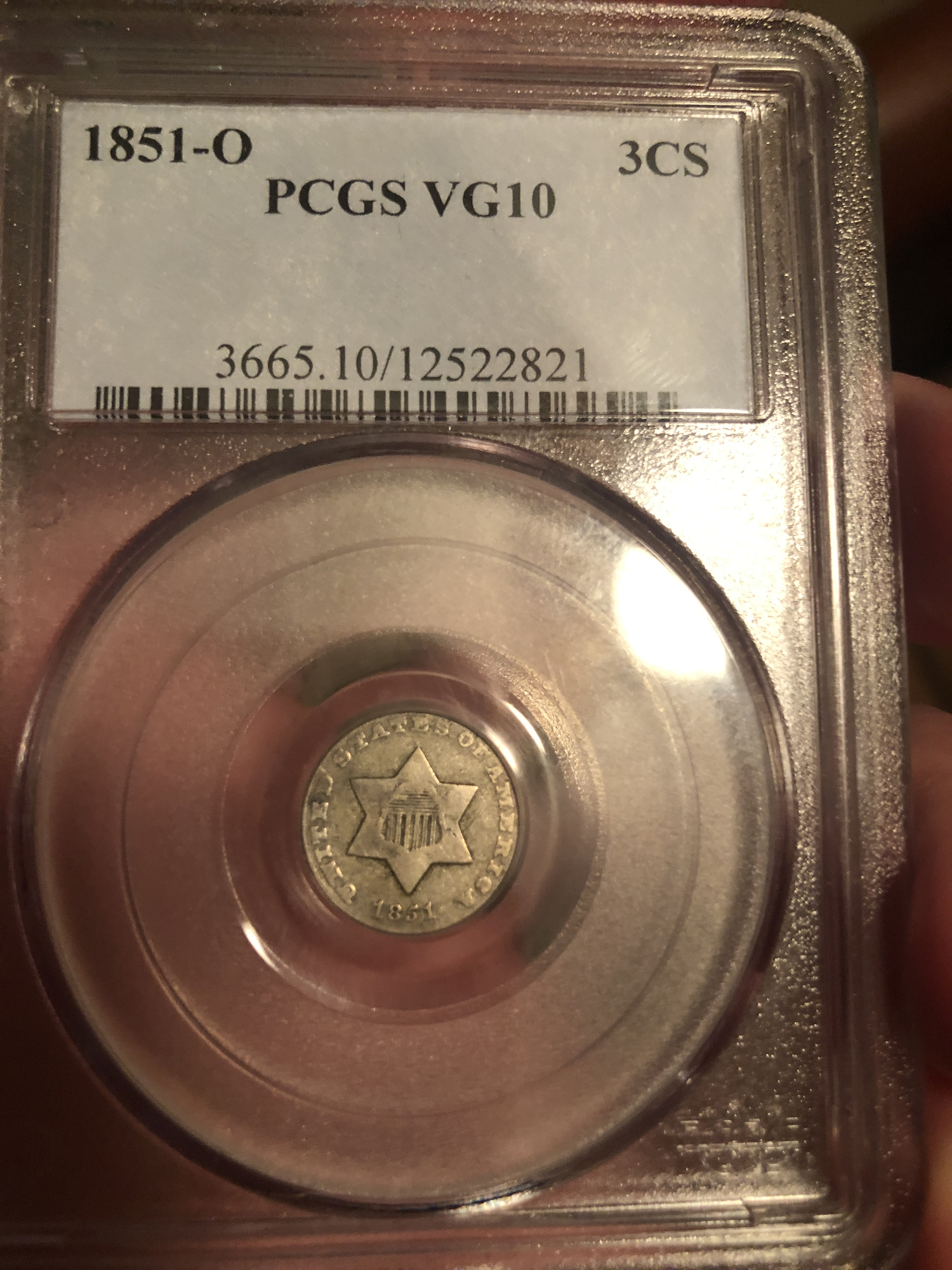
11.5$ Southern Dollars, The little “Big Easy” set
Thanks for the article! Here's one of mine.
Thank you for the well-written article! This is the kind of content that keeps bringing me back to the forum.
Thanks Bill for another well written post, as good as you will find in any numismatic reference, and probably better than most.
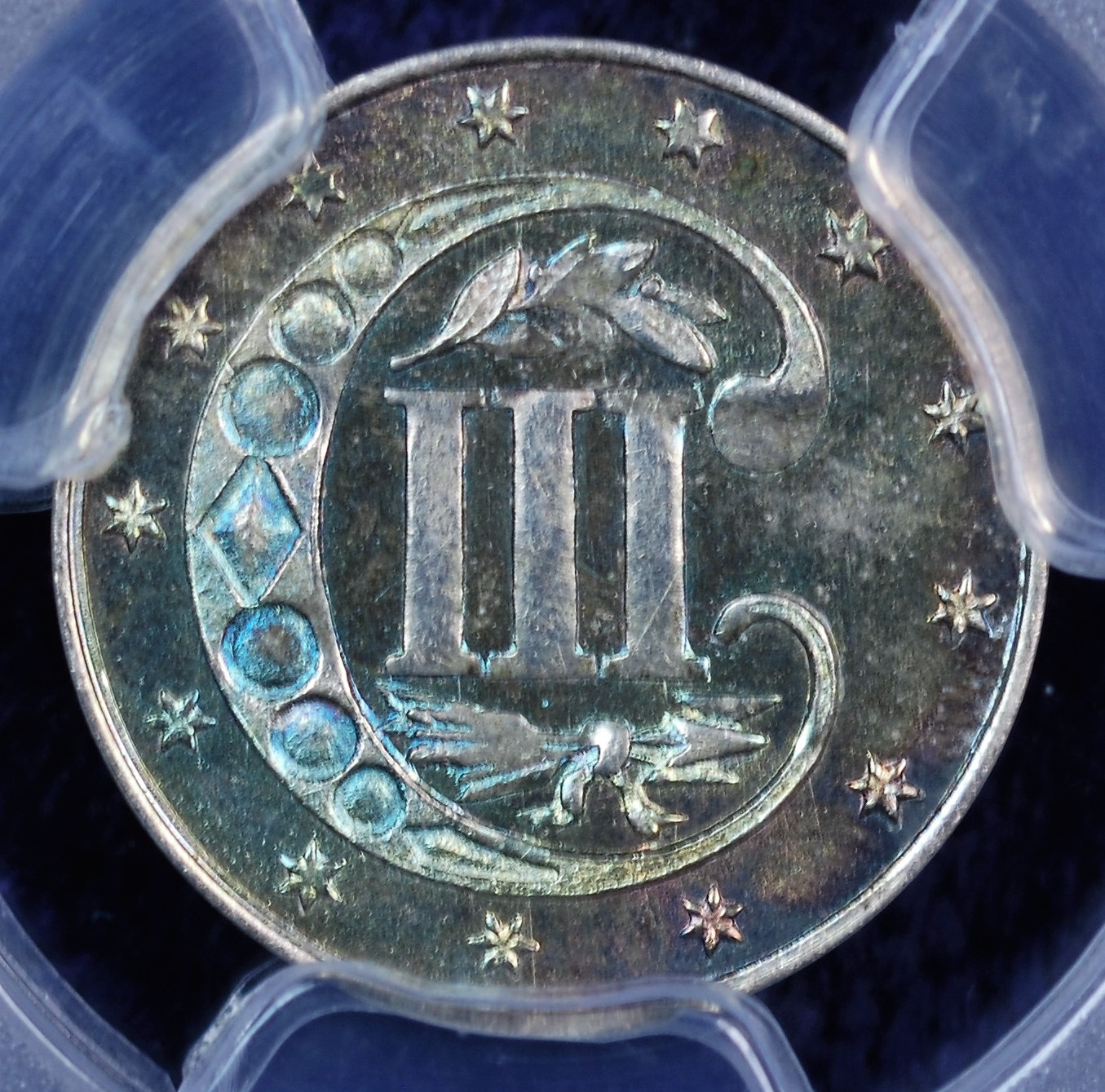
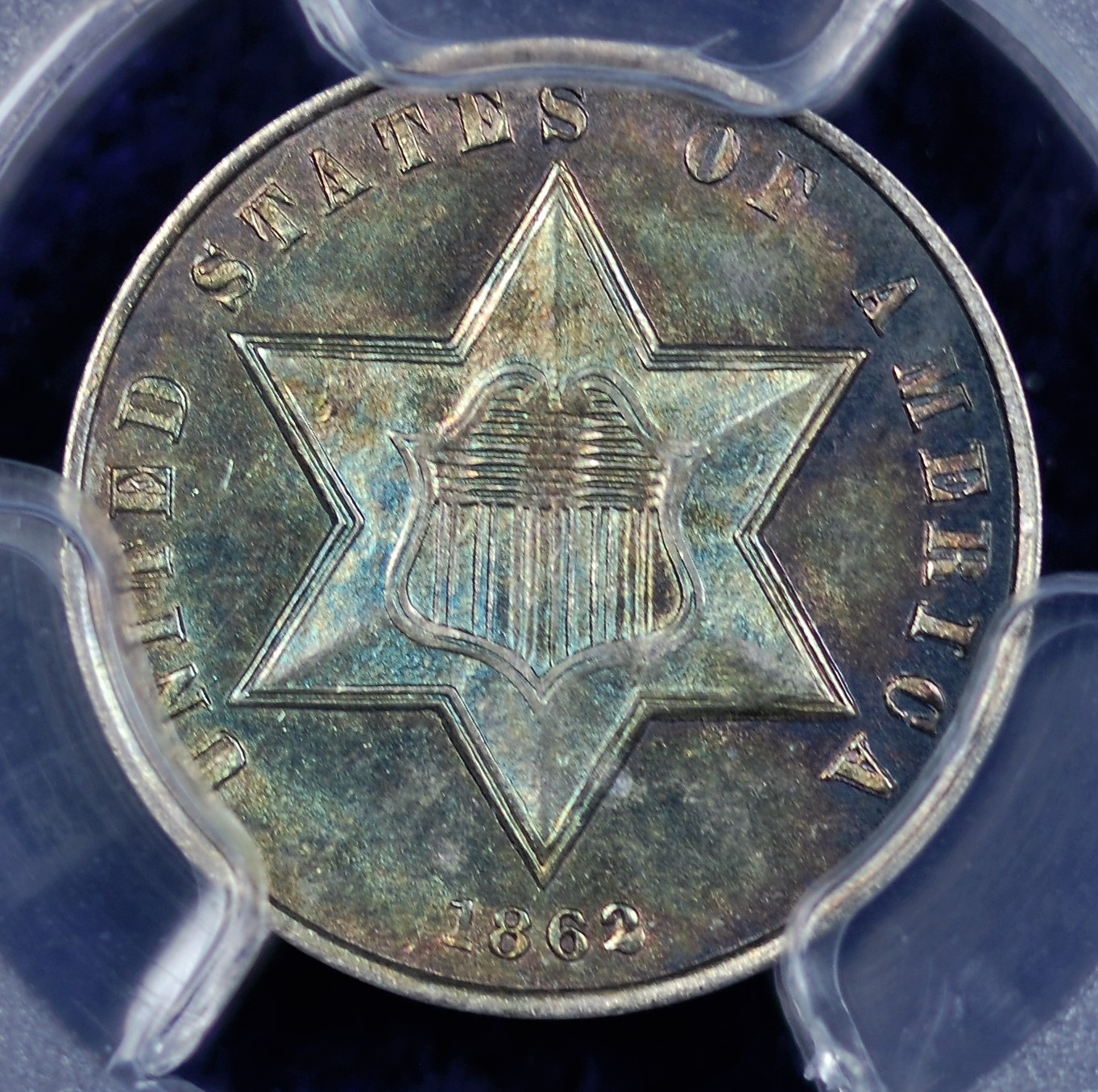
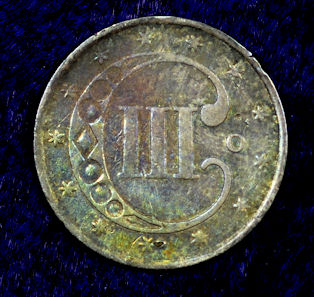
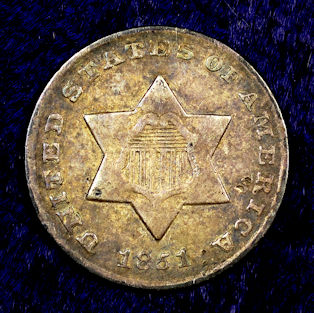
@kaz
That a nice 51-o doc
11.5$ Southern Dollars, The little “Big Easy” set
Excellent post @BillJones ... Very informative. These are amazing little coins and quite the interesting history. Cheers, RickO
thank you @BillJones for the great information. My contribution
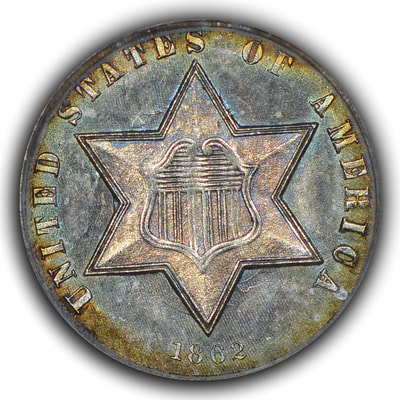
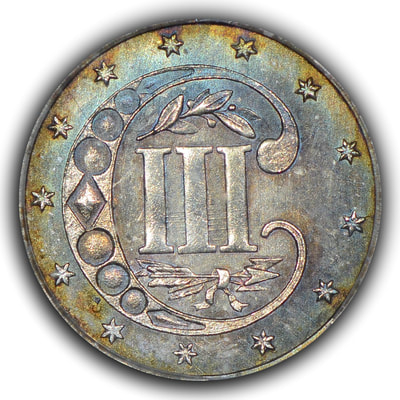
:
Top 10 Cal Fractional Type Set
successful BST with Ankurj, BigAl, Bullsitter, CommemKing, DCW(7), Downtown1974, Elmerfusterpuck, Joelewis, Mach1ne, Minuteman810430, Modcrewman, Nankraut, Nederveit2, Philographer(5), Proofcollection, Realgator, Silverpop, SurfinxHI, TomB and Yorkshireman(3)